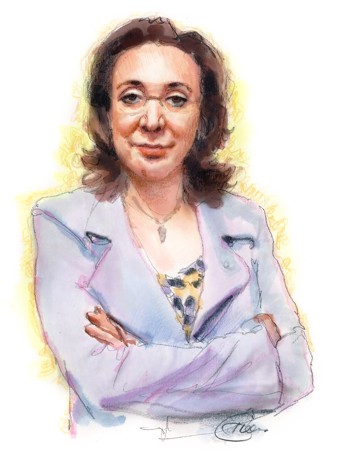Vol. 46, Issue 2 ‣ profile
Mexico Human Rights Activist Rosi Orozco

Human trafficking in Mexico, most often among teenage girls forced into prostitution, typically goes hand in hand with the country’s infamous drug cartels. But it has received far less public notice. Dramatic change is starting to happen due to the efforts of individuals such as human rights activist Rosi Orozco of Mexico City.
Now president of the nongovernmental Commission United Against Human Trafficking, as a member of the 61st legislature Orozco was the driving force in overcoming strong resistance and winning passage in 2012 of a tough new law to combat human trafficking throughout Mexico.
“People all over are linked to human trafficking, and sometimes they are political people. But a lot of Mexicans are sick and tired of this, including many politicians and friends here in Congress. We will fight this fight with all our hearts, all our minds and all our strength,” Orozco said during the political battle.
The bill is entitled the General Law to Prevent, Punish and Eradicate Crimes of Human Trafficking and to Protect and Assist the Victims of This Crime. Passed on June 14, 2012, it brings all Mexican states under the same extensive measures for prevention and punishment of trafficking. It grants increased powers for police and judges, granting anonymity and protection for victims, while simultaneously providing new funding for rehabilitation projects involving them.
Speaking of the challenges in gaining passage of the human trafficking law for Mexico, Orozco says the major resistance came from people who were reluctant to punish the clients who exploit women sold into sex trafficking. She argued that the law wasn’t going to work “unless we punish at every point in the chain of criminality, including the client. Until the demand ceases, there will be no end to this slavery.”
The improvements Orozco sees since the new law was enacted include a highly visible change: Hundreds of nightclubs that were involved in prostitution have been closed down. If an individual benefits economically from promoting the sale of a person or the pornographic exploitation of an individual—and their victim was deceived, threatened or lied to about her immigration status—the perpetrator can receive a sentence of up to 30 years in prison.
“This never happened under the old law,” Orozco says. “If two girls from Colombia wanted to come to Mexico, a website enticed them with ‘Do you want to be in paradise?’ and promised there would be no prostitution or drugs and they would have work permits. Then they arrived here and saw the place where they were to work—there were drugs, prostitution, and they would have no legal permission to work. They were just going to be held here. Article 13 of the 2012 law states that after the first lie is told to lure a victim, a crime has been committed.”
The law has a sordid legacy to combat. Sex workers in Mexico City can service between 20 and 40 clients daily at $15 per encounter, with their pimp pocketing $25,000 per month or more and the girls kept in bondage with threats against them or their families. Poverty and fear sustain the trade.
Sex workers are also a “social convenience” in Mexico, says Orozco. “There are a lot of boys who, when they are 14 or 15 years old, will be taken by their father to a prostitute or bordello. We have to start changing the minds of a lot of men who see this as a natural part of Mexican culture.”
Most Americans think slavery was abolished 150 years ago… But human trafficking is now called modern-day slavery for good reason.
Human trafficking often goes hand in hand with Mexico’s drug gangs but makes far fewer front pages. Organized crime networks, both national and international, find enormous financial rewards in trafficking, one of the most profitable forms of illegal income worldwide. Add to this the rampant corruption in Mexico among police, the judiciary and senior politicians, and you have an outsize problem to handle, Orozco says.
With victims from Mexico and other countries sold into the United States, Canada and Europe, Orozco has in the two years since passage of the landmark Mexican bill continued to advocate for increasingly stronger international cooperation to bring an end to the trafficking menace.
Orozco is forceful in her campaign to produce change in the United States, pushing for modifications in both the trafficking laws and in morality that she believes need to happen across the border to make a genuine difference.
“There must be a shift in the American mindset,” she says, pointing out that most Americans think slavery was abolished 150 years ago, and many think trafficking is a problem only in other countries. “But human trafficking is now called modern-day slavery for good reason. It is slavery, quite simply. It involves people who are chronically abused and have no ability to stop it.”
Anyone who works on trafficking laws, Orozco says, should meet with actual victims. “I have seen many academics and legislators involved in the issue who have never sat down with a victim. They have never seen firsthand the reality of trafficking. They have only read about it in books.” Orozco says the U.S. laws must change, too. “If you don’t punish every point on the chain of human trafficking and all the elements of exploitation, you will never end it in America or anywhere else.”
She describes how the chain of trafficking operates: “Riders” take teenage girls from the border or from other cities and turn them over to “deliverers,” who pass out cards that advertise “chicas” with a phone number to call. They transport a girl to a client as if she were a simple retail commodity. “The client is also a criminal and should go to jail along with the suppliers,” Orozco reasons. “How can a man say he did not know that a young girl was a victim?”
There is much that U.S. legislators should know about what happens at the Mexican border, beginning with the acknowledgement that the corruption thrives on both sides, Orozco maintains.
“I have interviewed both traffickers and their victims,” she says, “and everyone who has crossed the border from Mexico to the United States admits that they crossed with impunity. A pimp who was in jail boasted to me about how easy it was to cross with minor girls 16 and 17 years old.
“He took them through a Sonora tunnel with a hospital on the other side. They didn’t go to the hospital, though—vans were waiting for them. They had no problem crossing. Pay $5,000 to cross and it ensures that everyone who should be stopping it and protecting the victims looks the other way.”
Nonprofit organizations play a huge role in addressing the issue, Orozco finds. “In the U.S., dozens of groups are addressing various aspects of the problem. Some provide intervention and shelters, some provide support and counseling, some educate and raise awareness. They all play a role, but they must gain force and effectiveness and speed. We all must make this slavery disappear forever.”
Orozco believes that it will take great persistence and courage to bring down such a sinister and profitable enterprise as the trafficking that she calls slavery. But it can be done. To her mind, the answer “begins with individuals caring about other people, noticing what’s going on in their neighborhoods and being willing to face up to traffickers and drive them out.
“We all have to refuse to tolerate this crime against humanity any longer. When prosecution or the threat of it reaches everyone involved in the trafficking chain, and when we all stand up and say ‘No!’ because we are no longer blind to the crime—that is when we will see the end of slavery.”






























